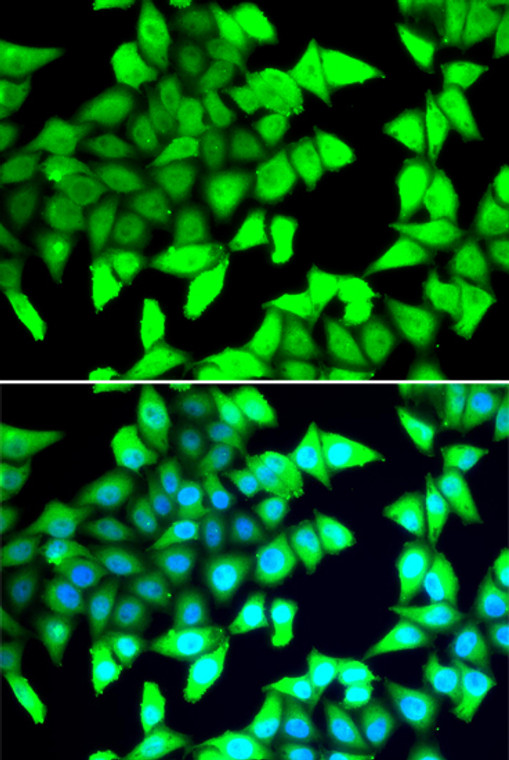| Host: |
Rabbit |
| Applications: |
WB/IF/ICC/ELISA |
| Reactivity: |
Human |
| Note: |
STRICTLY FOR FURTHER SCIENTIFIC RESEARCH USE ONLY (RUO). MUST NOT TO BE USED IN DIAGNOSTIC OR THERAPEUTIC APPLICATIONS. |
| Clonality: |
Polyclonal |
| Conjugation: |
Unconjugated |
| Isotype: |
IgG |
| Formulation: |
PBS with 0.02% Sodium Azide, 50% Glycerol, pH 7.3. |
| Purification: |
Affinity purification |
| Concentration: |
Lot specific |
| Dilution Range: |
WB:1:500-1:2000IF/ICC:1:20-1:50ELISA:Recommended starting concentration is 1 Mu g/mL. Please optimize the concentration based on your specific assay requirements. |
| Storage Instruction: |
Store at-20°C for up to 1 year from the date of receipt, and avoid repeat freeze-thaw cycles. |
| Gene Symbol: |
HDAC5 |
| Gene ID: |
10014 |
| Uniprot ID: |
HDAC5_HUMAN |
| Immunogen Region: |
350-450 |
| Specificity: |
A synthetic peptide corresponding to a sequence within amino acids 350-450 of human HDAC5 (NP_005465.2). |
| Immunogen Sequence: |
RALPLDSSPNQFSLYTSPSL PNISLGLQATVTVTNSHLTA SPKLSTQQEAERQALQSLRQ GGTLTGKFMSTSSIPGCLLG VALEGDGSPHGHASLLQHVL L |
| Tissue Specificity | Ubiquitous. |
| Post Translational Modifications | Phosphorylated by AMPK, CaMK1, SIK1 and PRKD1 at Ser-259 and Ser-498. The phosphorylation is required for the export to the cytoplasm and inhibition. Phosphorylated by the PKC kinases PKN1 and PKN2, impairing nuclear import. Phosphorylated by GRK5, leading to nuclear export of HDAC5 and allowing MEF2-mediated transcription. Ubiquitinated. Polyubiquitination however does not lead to its degradation. |
| Function | Responsible for the deacetylation of lysine residues on the N-terminal part of the core histones (H2A, H2B, H3 and H4). Histone deacetylation gives a tag for epigenetic repression and plays an important role in transcriptional regulation, cell cycle progression and developmental events. Histone deacetylases act via the formation of large multiprotein complexes. Involved in muscle maturation by repressing transcription of myocyte enhancer MEF2C. During muscle differentiation, it shuttles into the cytoplasm, allowing the expression of myocyte enhancer factors. Involved in the MTA1-mediated epigenetic regulation of ESR1 expression in breast cancer. Serves as a corepressor of RARA and causes its deacetylation. In association with RARA, plays a role in the repression of microRNA-10a and thereby in the inflammatory response. |
| Protein Name | Histone Deacetylase 5Hd5Antigen Ny-Co-9 |
| Database Links | Reactome: R-HSA-2122947Reactome: R-HSA-2644606Reactome: R-HSA-2894862Reactome: R-HSA-350054Reactome: R-HSA-8943724 |
| Cellular Localisation | NucleusCytoplasmShuttles Between The Nucleus And The CytoplasmIn Muscle CellsIt Shuttles Into The Cytoplasm During Myocyte DifferentiationThe Export To Cytoplasm Depends On The Interaction With A 14-3-3 Chaperone Protein And Is Due To Its Phosphorylation At Ser-259 And Ser-498 By AmpkCamk1 And Sik1 |
| Alternative Antibody Names | Anti-Histone Deacetylase 5 antibodyAnti-Hd5 antibodyAnti-Antigen Ny-Co-9 antibodyAnti-HDAC5 antibodyAnti-KIAA0600 antibody |
Information sourced from Uniprot.org
12 months for antibodies. 6 months for ELISA Kits. Please see website T&Cs for further guidance








